CalGreen Tiers
CalGreen Tiers

The CalGreen tiers are the so-called “voluntary” measures of the California Green Building Standards Code (CalGreen). The Tier requirements are only “voluntary” for the building department to adopt, or not adopt. If adopted, they are mandatory for your project.
The CalGreen Code is the statewide code requiring sustainable design for residential and non-residential buildings. In most cases, alterations and additions also require compliance. The code has essentially two parts, the Mandatory Measures and the Voluntary Measures (tiers).
The CalGreen Mandatory Measures contains requirements applicable to all residential and non-residential projects. The measures are the minimum sustainable goals for your project. If your project requires a Tier compliance, you also must comply with all of the mandatory measures.
The code encourages local jurisdictions to raise the sustainable goals by publishing two “voluntary” tiers of additional requirements. They are called Tier 1 and Tier 2. Tier 1 adds additional requirements beyond the mandatory measures. Tier 2 further increases the requirements.
The CalGreen Tiers are only mandatory where local ordinances have specifically adopted them. Local adoption varies widely throughout the state. The more progressive jurisdictions have adopted many of the Tier 1 requirements. Few of the local jurisdictions have yet to adopt Tier 2 requirements, though this is to be expected in the near future. It is important to check with your local building department to see if they have adopted any of the Tier 1 or 2 requirements.
Keep in mind that all CalGreen requirements must be noted or detailed on the permit documents, in addition to being noted on the checklist.
The Catch 22 of Your Building Department’s Checklist

Compliance with all of the applicable requirements of the CalGreen Code is required by California State law, unless specifically amended by local jurisdictions. Unfortunately this is not the case in many jurisdictions. What is happening is that building department’s throughout the state are creating their own CalGreen Checklist. They are arbitrarily deleting requirements to simplify their review. This is being done without amending their municipal code.
When trying to understand the requirements for the CalGreen Code and the Tier requirements you cannot simply review the CalGreen Code. You must check with your jurisdiction to find out if they have made any arbitrary changes to the code, or Tier, requirements.
In almost all cases we have reviewed, jurisdictions that have created their own modified checklist have not officially amended the changes in their municipal code. The rule of law regarding adopted codes is that they must be complied with unless specifically amended.Technically they are violating both California State law as well as the law of their own municipality!
The above scenario creates a catch-22 in every jurisdiction that has published their own checklist. The problem is, if an item is not on your local checklist, do you still have to comply with it? Technically, under state law, you do. On the other hand, if your local jurisdiction doesn’t care to enforce certain items, then why comply?
We recommend just following your local checklist. Why spend more money on complying with items your jurisdiction is not going to enforce?
CalGreen Residential Tier 1 Requirements

We are going to refer to the Tier 1 checklist that is in the 2019 California Green Building Standards Code. However, no one actually uses this checklist. Why? Well because the code is published by a private company, the International Code Council (ICC). At the bottom of every page in the code it states, “Any unauthorized reproduction or distribution is a violation of the Federal Copyright Act and the licence agreement, and subject to civil and criminal penalties thereunder”.
So, you can’t copy or reproduce the California CalGreen Code’s checklist (and YES, this makes no sense whatsoever). However, since it is the official code checklist we will use it’s contents for this effort.
The key points of complying with either Tier 1 or Tier 2 are:
-
- You must comply with all of the Mandatory Measures.
- Each Tier section has prerequisites that must be complied with.
- Each Tier section provides a number of “elective” options for compliance. Depending on the section, you have to pick two or more electives from a list of four or more.
The CalGreen Checklist is broken down into five sections. These are:
1. Planning and Design
2. Energy Efficiency
3. Water Efficiency and Conservation
4. Material Conservation and Resource Efficiency
5. Environmental Quality
To achieve Tier 1 status a project must comply with the following:
In addition to the mandatory measures the project must comply with the following prerequisite and elective measures to achieve Tier 1 status.
1. From Division A4.1, Planning and Design.
1.1. Comply with the topsoil protection requirements in Section A4.106.2.3.
1.2. Comply with the 20 percent permeable paving
requirements in Section A4.106.4.
1.3. Comply with the cool roof requirements in Section A4.106.5
1.4. Comply with the Tier 1 electric vehicle (EV) charging requirements in Section A4.106.8.
1.5. Comply with at least two elective measures selected from Division A4.1.
2. From Division A4.2, Energy Efficiency.
2.1. For newly constructed low-rise residential buildings, comply with the energy efficiency requirements in Sections A4.203.1.1.1, A4.203.1.1.2, Table A4.203.1.1.1, A4.203.1.2, A4.203.1.3.1 and A4.203.1.4.
3. From Division A4.3, Water Efficiency and Conservation.
3.1. Comply with at least two elective measures selected from Division A4.3.
4. From Division A4.4, Material Conservation and Resource Efficiency.
4.1. Comply with the 20 percent cement reduction requirements in Section A4.403.2.
4.2. Comply with the 10 percent recycled content requirements in Section A4.405.3.1.
4.3. Comply with the 65 percent reduction in construction waste in Section A4.408.1.
4.4. Comply with at least two elective measures selected from Division A4.4.
5. From Division A4.5, Environmental Quality.
5.1. Comply with the 90 percent resilient flooring systems requirements in Section A4.504.2.
5.2. Comply with the thermal insulation requirements for Tier 1 in Section A4.504.3.
5.3. Comply with at least one elective measure selected from Division A4.5.
The Tier 1 requirements place a burden on the entire design team to ensure the project meets the code. In addition, every elective adds time an material costs to the project. This affects not only the construction, but the design effort as well. Therefore it is necessary to carefully evaluate each elective to understand the design and cost implications. In the same elective group one item may have near zero cost, while another may add thousands of dollars to the project.
We strongly recommend to our clients that they engage a CalGreen specialist anytime they have a project that must comply with Tier 1 or 2. A Calgreen specialist can guide your design team to make the right choices for your project.
CalGreen Tier 1 Electives
The sheer number of electives for each of the five sections are too numerous to list here. Click on the image below. It will open in a new window and display the complete checklist with all of the electives high-lighted in yellow. In case your wondering, yes, the checklist below is from the copyrighted code which means we will probably be sued out of existence….
Your Local CalGreen Checklist

The Santa Rosa CalGreen Checklist with Tier 1
Many jurisdictions produce their own CalGreen Checklist. If they do, you must use their checklist. They will not accept the one produced by the California AIA nor the one from the California Department of Housing and Community Development. If in doubt, call your building department plans desk and ask which checklist to use. Or you can call us and we will tell you.
Generally speaking, the local jurisdictions publish their own checklist to simplify their review. The simplification comes, in some cases, from deleting some of the code requirements. They also make changes to clarify the frequently confusing language of the CalGreen Code.
The reality is, CalGreen is confusing. Confusing not only to architects, designer and builders, but also to the local plan reviewers and inspectors. Unfortunately, the 2019 code update did little to improve the communication process.
At CalGreen Energy Services we provide clarity to the CalGreen Tiers. We guide you through the process to make the right choices for your project. In addition, we ensure that your architectural and engineering plans have incorporated the CalGreen requirements correctly.
We are specialists in the CalGreen Code. CalGreen is our only business. If you have a CalGreen question please feel free to give us a call. We are happy to share our knowledge.
Call us today and let us show you how we can help with your project.
Gary Welch
Email: gary@calgreenenergyservices.com
Phone: 707-328-5299


Gary Welch has over 35 years experience in the field of sustainable building design. He is the CEO of CalGreen Energy Services. Gary is an ICC Certified CalGreen Special Inspector and Plans Examiner.


